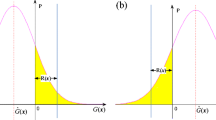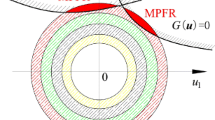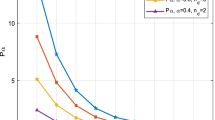Abstract
Evidence theory-based reliability analysis (ETRA) is investigated in this paper. To estimate the plausibility (Pl) and belief (Bel) measures of failure probability, the active learning method based on Kriging model for ETRA (ALK-ETRA) has been proposed. However, ALK-ETRA pays too much attention to rightly predicting the signs of performance function at points throughout the uncertain space. To minimize the waste of training points, an enhanced version of ALK-ETRA (En-ALK-ETRA) is proposed in this paper. Pl or Bel is determined by the sign associated with an individual joint focal element (JFE) rather than a single point. Based on this idea, a brand-new learning function and a novel stopping condition are proposed in En-ALK-ETRA. Aided by the new learning function, the most dangerous JFE in which the lower (or upper) bound of performance function has the largest probability of wrong sign prediction is identified. The added training point is chosen from the most dangerous JFE and thus the convergence speed of learning process is accelerated. In the new stopping condition, the number of JFEs where the minimum (or maximum) of performance function with wrong sign predictions is explicitly deduced and thus the error of ETRA can be estimated. The error of ETRA is real-time monitored and thus the learning process is timely terminated without accuracy sacrifice. The performance of the proposed method is demonstrated by six case studies.













Similar content being viewed by others
Abbreviations
- n X :
-
Total number of epistemic variables
- n j :
-
Total number of focal elements of the jth (j = 1, ⋯, nX) variable
- n E :
-
Total number of joint focal elements of all variable
- N MC :
-
Total number of samples of interval Monte Carlo simulation
- N A :
-
Total number of samples in each joint focal element
- N T :
-
Total number of training points of Kriging model
- \( {A}_j^i \) :
-
The ith (i = 1, ⋯, nj) focal element of the jth variable
- \( {\tilde{N}}_F^{Bel} \) :
-
Total number of joint focal elements which are predicted to be in the failure region
- \( {N}_F^{Bel} \) :
-
Total number of joint focal elements which are truly in the failure region
- \( {N}_{\mathrm{wsp}}^{\mathrm{max}} \) :
-
Total number of joint focal elements where the sign predictions for maximum of performance function are wrong
- \( {\overline{N}}_{\mathrm{wsp}}^{\mathrm{max}} \) :
-
Upper-bound estimation of \( {N}_{\mathrm{wsp}}^{\mathrm{max}} \)
- \( {N}_{\mathrm{wsp}}^{\mathrm{min}} \) :
-
True number of joint focal elements where the sign predictions for the minimum of performance function are wrong
- \( {\overline{N}}_{\mathrm{wsp}}^{\mathrm{min}} \) :
-
Upper-bound estimation of \( {N}_{\mathrm{wsp}}^{\mathrm{min}} \)
- N r :
-
A constant in stopping condition
- A k :
-
The kth (k = 1, 2, ⋯, nE) joint focal element
- A (k) :
-
The kth sample of interval Monte Carlo simulation
- JFE:
-
Joint focal element
- ETRA:
-
Evidence theory-based reliability analysis
- Bel :
-
Belief measure of the failure probability
- Pl :
-
Plausibility measure of the failure probability
- CPM:
-
Cartesian product method
- IMCS:
-
Interval Monte Carlo simulation
- MPFE:
-
Most probable focal element
- RS:
-
Response surface
- FARM/SARM:
-
First-order and second-order approximate reliability methods
- DRD:
-
Dimension reduction decomposition
- ALK:
-
Active learning methods based on Kriging
- BPA:
-
Basic probability assignment
- Cov:
-
Coefficients of variation
- LHS:
-
Latin hypercube sampling
- DoE:
-
Design of experiments
- ERF:
-
Expected risk function
- WSP:
-
Wrong sign prediction
References
Alvarez DA (2006) On the calculation of the bounds of probability of events using infinite random sets. Int J Approx Reason 43:241–267
Alvarez DA (2009) A Monte Carlo-based method for the estimation of lower and upper probabilities of events using infinite random sets of indexable type. Fuzzy Sets Syst 160:384–401
Alvarez DA, Hurtado JE (2014) An efficient method for the estimation of structural reliability intervals with random sets, dependence modeling and uncertain inputs. Comput Struct 142:54–63
Au S, Beck JL (1999) A new adaptive importance sampling scheme for reliability calculations. Struct Saf 21:135–158
Au S-K, Beck JL (2001) Estimation of small failure probabilities in high dimensions by subset simulation. Probabilistic Engineering Mechanics 16:263–277
Bae HR, Grandhi RV, Canfield RA (2003) Uncertainty quantification of structural response using evidence theory. AIAA J 41:2062–2068
Bae HR, Grandhi RV, Canfield RA (2004a) An approximation approach for uncertainty quantification using evidence theory. Reliab Eng Syst Saf 86:215–225
Bae H-R, Grandhi RV, Canfield RA (2004b) Epistemic uncertainty quantification techniques including evidence theory for large-scale structures. Comput Struct 82:1101–1112
Bai YC, Han X, Jiang C et al (2012) Comparative study of metamodeling techniques for reliability analysis using evidence theory. Adv Eng Softw 53:61–71
Balu A, Rao B (2014) Efficient assessment of structural reliability in presence of random and fuzzy uncertainties. J Mech Des 136:051008
Bichon BJ, Eldred MS, Swiler LP et al (2008) Efficient global reliability analysis for nonlinear implicit performance functions. AIAA J 46:2459–2468
Cao L, Liu J, Han X et al (2018) An efficient evidence-based reliability analysis method via piecewise hyperplane approximation of limit state function. Struct Multidiscip Optim 58:201–213
Cao L, Liu J, Jiang C et al (2019) Evidence-based structural uncertainty quantification by dimension reduction decomposition and marginal interval analysis. J Mech Des 142
Crespo LG, Kenny SP, Giesy DP (2013) Reliability analysis of polynomial systems subject to p-box uncertainties. Mech Syst Signal Process 37:121–136
Der Kiureghian A, Dakessian T (1998) Multiple design points in first and second-order reliability. Struct Saf 20:37–49
Echard B, Gayton N, Lemaire M (2011) AK-MCS: an active learning reliability method combining Kriging and Monte Carlo simulation. Struct Saf 33:145–154
Fei C-W, Lu C, Liem RP (2019) Decomposed-coordinated surrogate modeling strategy for compound function approximation in a turbine-blisk reliability evaluation. Aerosp Sci Technol 95:105466
Guo J, Du X (2007) Sensitivity analysis with mixture of epistemic and aleatory uncertainties. AIAA J 45:2337–2349
Helton JC, Johnson J, Oberkampf W et al (2007) A sampling-based computational strategy for the representation of epistemic uncertainty in model predictions with evidence theory. Comput Methods Appl Mech Eng 196:3980–3998
Impollonia N, Muscolino G (2011) Interval analysis of structures with uncertain-but-bounded axial stiffness. Comput Methods Appl Mech Eng 200:1945–1962
Jiang C, Zhang Z, Han X et al (2013) A novel evidence-theory-based reliability analysis method for structures with epistemic uncertainty. Comput Struct 129:1–12
Jiang C, Qiu H, Gao L et al (2020) Real-time estimation error-guided active learning Kriging method for time-dependent reliability analysis. Appl Math Model 77:82–98
Johnson O (2004) Information theory and the central limit theorem: World Scientific
Joslyn C, Kreinovich V (2005) Convergence properties of an interval probabilistic approach to system reliability estimation. Int J Gen Syst 34:465–482
Kaymaz I (2005) Application of Kriging method to structural reliability problems. Struct Saf 27:133–151
Li G, Lu Z, Lu Z et al (2014) Regional sensitivity analysis of aleatory and epistemic uncertainties on failure probability. Mech Syst Signal Process 46:209–226
Limbourg P, Rocquigny E (2010) Uncertainty analysis using evidence theory – confronting level-1 and level-2 approaches with data availability and computational constraints. Reliab Eng Syst Saf 95:550–564
Ohsaki M, Ikeda K (2007) Stability and optimization of structures: generalized sensitivity analysis: Springer Science & Business Media
Papadopoulos V, Giovanis DG, Lagaros ND et al (2012) Accelerated subset simulation with neural networks for reliability analysis. Comput Methods Appl Mech Eng 223:70–80
Qiu Z, Yang D, Elishakoff I (2008) Probabilistic interval reliability of structural systems. Int J Solids Struct 45:2850–2860
Roy A, Manna R, Chakraborty S (2019) Support vector regression based metamodeling for structural reliability analysis. Probabilistic Engineering Mechanics 55:78–89
Sadeghi N, Fayek AR, Pedrycz W (2010) Fuzzy Monte Carlo simulation and risk assessment in construction. Computer-Aided Civil and Infrastructure Engineering 25:238–252
Shah H, Hosder S, Winter T (2015a) Quantification of margins and mixed uncertainties using evidence theory and stochastic expansions. Reliab Eng Syst Saf 138:59–72
Shah H, Hosder S, Winter T (2015b) A mixed uncertainty quantification approach using evidence theory and stochastic expansions. Int J Uncertain Quantif 5:21–48
Sun Z, Wang C, Niu X et al (2016) A response surface approach for reliability analysis of 2.5D C/SiC composites turbine blade. Compos Part B 85:277–285
Sun Z, Wang J, Li R et al (2017) LIF: a new Kriging based learning function and its application to structural reliability analysis. Reliab Eng Syst Saf 157:152–165
Tonon F, Bae H-R, Grandhi RV et al (2006) Using random set theory to calculate reliability bounds for a wing structure. Struct Infrastruct Eng 2:191–200
Wang C (2019) Evidence-theory-based uncertain parameter identification method for mechanical systems with imprecise information. Comput Methods Appl Mech Eng 351:281–296
Wang C, Matthies HG (2019) Epistemic uncertainty-based reliability analysis for engineering system with hybrid evidence and fuzzy variables. Comput Methods Appl Mech Eng 355:438–455
Wang Z, Shafieezadeh A (2019) REAK: reliability analysis through error rate-based adaptive Kriging. Reliab Eng Syst Saf 182:33–45
Wang Z, Shafieezadeh A (2020) On confidence intervals for failure probability estimates in Kriging-based reliability analysis. Reliab Eng Syst Saf 196:106758
Wang C, Matthies HG, Xu M et al (2018) Evidence-theory-based model validation method for heat transfer system with epistemic uncertainty. Int J Therm Sci 132:618–627
Wassily H, Robbins H (1948) The central limit theorem for dependent random variables. Duke Mathematical Journal 15:773–780
Wei P, Song J, Bi S et al (2019) Non-intrusive stochastic analysis with parameterized imprecise probability models: II. Reliability and rare events analysis. Mech Syst Signal Process 126:227–247
Xiao M, Gao L, Xiong H et al (2015) An efficient method for reliability analysis under epistemic uncertainty based on evidence theory and support vector regression. J Eng Des 26:340–364
Xiao M, Zhang J, Gao L (2020a) A system active learning Kriging method for system reliability-based design optimization with a multiple response model. Reliab Eng Syst Saf 199:106935
Xiao N-C, Yuan K, Zhou C (2020b) Adaptive Kriging-based efficient reliability method for structural systems with multiple failure modes and mixed variables. Comput Methods Appl Mech Eng 359:112649
Yang X, Liu Y, Zhang Y et al (2015a) Probability and convex set hybrid reliability analysis based on active learning Kriging model. Appl Math Model 39:3954–3971
Yang X, Liu Y, Gao Y et al (2015b) An active learning Kriging model for hybrid reliability analysis with both random and interval variables. Struct Multidiscip Optim 51:1003–1016
Yang X, Liu Y, Ma P (2017) Structural reliability analysis under evidence theory using the active learning Kriging model. Eng Optim 49:1922–1938
Yang X, Mi C, Deng D et al (2019) A system reliability analysis method combining active learning Kriging model with adaptive size of candidate points. Struct Multidiscip Optim 60:137–150
Yang X, Wang T, Li J et al (2020) Bounds approximation of limit-state surface based on active learning Kriging model with truncated candidate region for random-interval hybrid reliability analysis. Int J Numer Methods Eng 121:1345–1366
Yin S, Yu D, Yin H et al (2017) A new evidence-theory-based method for response analysis of acoustic system with epistemic uncertainty by using Jacobi expansion. Comput Methods Appl Mech Eng 322:419–440
Zhang Z, Jiang C, Wang GG et al (2015) First and second order approximate reliability analysis methods using evidence theory. Reliab Eng Syst Saf 137:40–49
Zhang J, Xiao M, Gao L et al (2018) A novel projection outline based active learning method and its combination with Kriging metamodel for hybrid reliability analysis with random and interval variables. Comput Methods Appl Mech Eng 341:32–52
Zhang J, Xiao M, Gao L et al (2019) A bounding-limit-state-surface-based active learning Kriging method for hybrid reliability analysis under random and probability-box variables. Mech Syst Signal Process 134:106310
Funding
This work is supported by the National Natural Science Foundation of China (Grant No. 51705433), the Sichuan Science and Technology Program (Grant No. 2021YFG0178), and the Fundamental Research Funds for the Central Universities (Grant No. 2682017CX028).
Author information
Authors and Affiliations
Corresponding author
Ethics declarations
Conflict of interest
The authors declare that they have no conflict of interest.
Replication of results
Details on the numerical implementation for the replication of the results have been provided in Section 6, with the pseudocode and the optimization parameters. The detailed procedures of the proposed method are given in Section 5. If the information provided in the paper is not enough, we sincerely welcome scientists or interested parties to contact us for further explanation. Data or implementation code is available upon request.
Additional information
Responsible Editor: Gengdong Cheng
Publisher’s note
Springer Nature remains neutral with regard to jurisdictional claims in published maps and institutional affiliations.
Rights and permissions
About this article
Cite this article
Yang, X., Zeqing, L. & Cheng, X. An enhanced active learning Kriging model for evidence theory-based reliability analysis. Struct Multidisc Optim 64, 2165–2181 (2021). https://doi.org/10.1007/s00158-021-02973-5
Received:
Revised:
Accepted:
Published:
Issue Date:
DOI: https://doi.org/10.1007/s00158-021-02973-5




